Impact of Piracy on Merchant Vessels and International Law
VerifiedAdded on 2023/06/08
|6
|1587
|190
Essay
AI Summary
This academic essay explores the significant and persistent threat of piracy and armed robbery to merchant vessels and their crews. It highlights the historical context of piracy, referencing incidents like the USS Cole attack and the 9/11 attacks, to illustrate the devastating impacts of these acts. The essay delves into the complexities of maritime security, discussing the roles of the International Maritime Organization (IMO), the use of armed guards, and the legal frameworks governing maritime trade and security. It examines the challenges of balancing security measures with legal regulations, such as weapon smuggling and port entry restrictions. The essay concludes by emphasizing the need for effective and well-regulated sea protection frameworks to mitigate the risks faced by merchant vessels, providing a comprehensive overview of the challenges and potential solutions in combating piracy on the high seas.
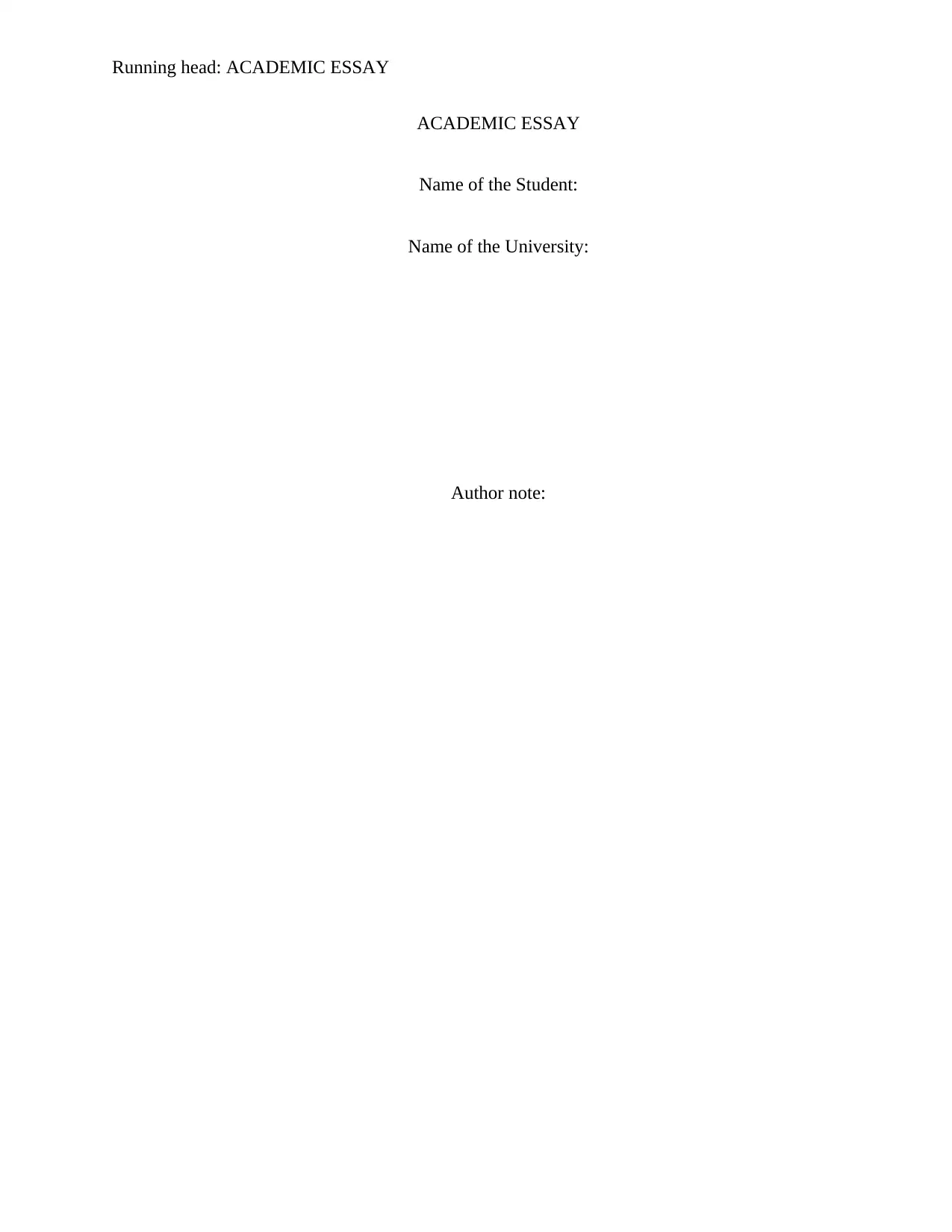
Running head: ACADEMIC ESSAY
ACADEMIC ESSAY
Name of the Student:
Name of the University:
Author note:
ACADEMIC ESSAY
Name of the Student:
Name of the University:
Author note:
Paraphrase This Document
Need a fresh take? Get an instant paraphrase of this document with our AI Paraphraser
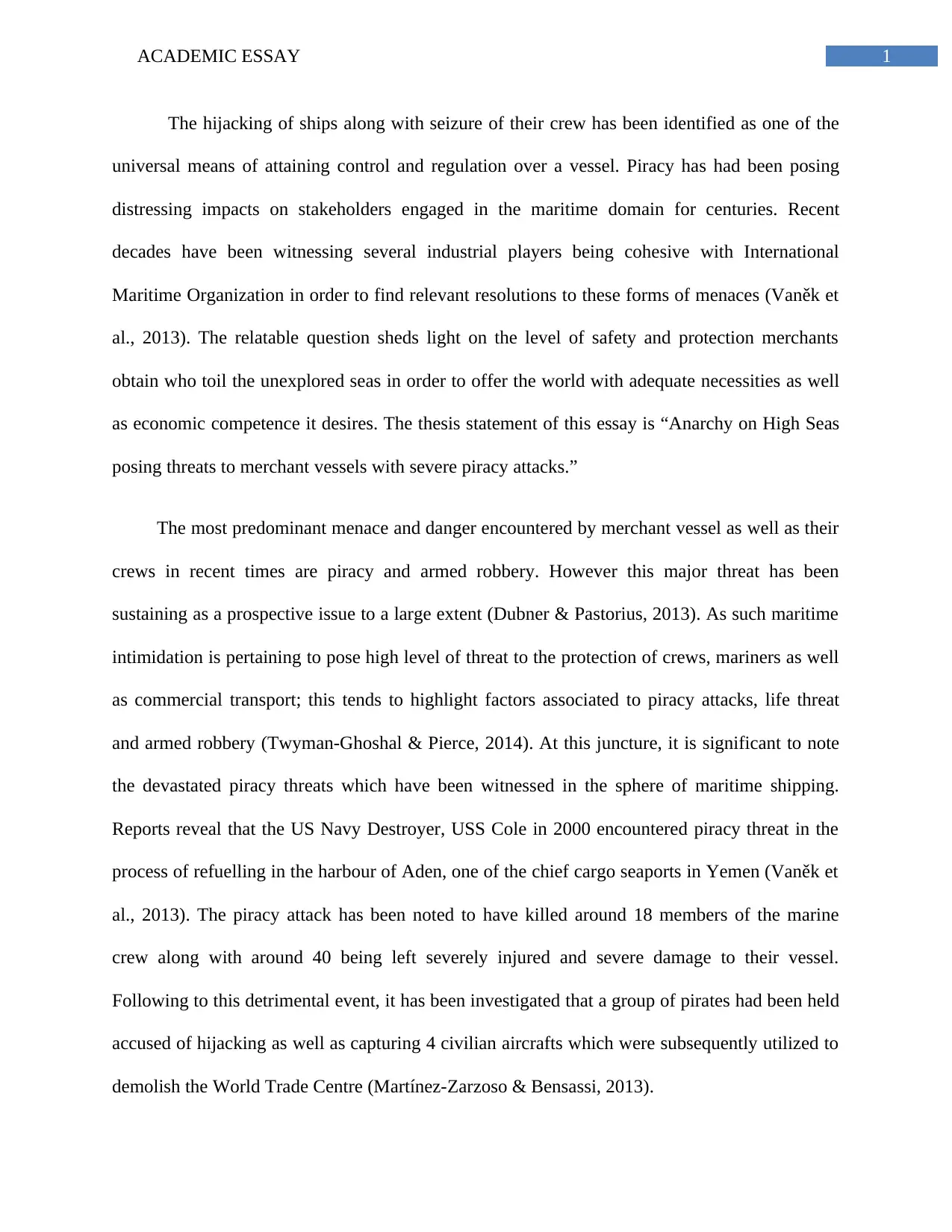
1ACADEMIC ESSAY
The hijacking of ships along with seizure of their crew has been identified as one of the
universal means of attaining control and regulation over a vessel. Piracy has had been posing
distressing impacts on stakeholders engaged in the maritime domain for centuries. Recent
decades have been witnessing several industrial players being cohesive with International
Maritime Organization in order to find relevant resolutions to these forms of menaces (Vaněk et
al., 2013). The relatable question sheds light on the level of safety and protection merchants
obtain who toil the unexplored seas in order to offer the world with adequate necessities as well
as economic competence it desires. The thesis statement of this essay is “Anarchy on High Seas
posing threats to merchant vessels with severe piracy attacks.”
The most predominant menace and danger encountered by merchant vessel as well as their
crews in recent times are piracy and armed robbery. However this major threat has been
sustaining as a prospective issue to a large extent (Dubner & Pastorius, 2013). As such maritime
intimidation is pertaining to pose high level of threat to the protection of crews, mariners as well
as commercial transport; this tends to highlight factors associated to piracy attacks, life threat
and armed robbery (Twyman-Ghoshal & Pierce, 2014). At this juncture, it is significant to note
the devastated piracy threats which have been witnessed in the sphere of maritime shipping.
Reports reveal that the US Navy Destroyer, USS Cole in 2000 encountered piracy threat in the
process of refuelling in the harbour of Aden, one of the chief cargo seaports in Yemen (Vaněk et
al., 2013). The piracy attack has been noted to have killed around 18 members of the marine
crew along with around 40 being left severely injured and severe damage to their vessel.
Following to this detrimental event, it has been investigated that a group of pirates had been held
accused of hijacking as well as capturing 4 civilian aircrafts which were subsequently utilized to
demolish the World Trade Centre (Martínez-Zarzoso & Bensassi, 2013).
The hijacking of ships along with seizure of their crew has been identified as one of the
universal means of attaining control and regulation over a vessel. Piracy has had been posing
distressing impacts on stakeholders engaged in the maritime domain for centuries. Recent
decades have been witnessing several industrial players being cohesive with International
Maritime Organization in order to find relevant resolutions to these forms of menaces (Vaněk et
al., 2013). The relatable question sheds light on the level of safety and protection merchants
obtain who toil the unexplored seas in order to offer the world with adequate necessities as well
as economic competence it desires. The thesis statement of this essay is “Anarchy on High Seas
posing threats to merchant vessels with severe piracy attacks.”
The most predominant menace and danger encountered by merchant vessel as well as their
crews in recent times are piracy and armed robbery. However this major threat has been
sustaining as a prospective issue to a large extent (Dubner & Pastorius, 2013). As such maritime
intimidation is pertaining to pose high level of threat to the protection of crews, mariners as well
as commercial transport; this tends to highlight factors associated to piracy attacks, life threat
and armed robbery (Twyman-Ghoshal & Pierce, 2014). At this juncture, it is significant to note
the devastated piracy threats which have been witnessed in the sphere of maritime shipping.
Reports reveal that the US Navy Destroyer, USS Cole in 2000 encountered piracy threat in the
process of refuelling in the harbour of Aden, one of the chief cargo seaports in Yemen (Vaněk et
al., 2013). The piracy attack has been noted to have killed around 18 members of the marine
crew along with around 40 being left severely injured and severe damage to their vessel.
Following to this detrimental event, it has been investigated that a group of pirates had been held
accused of hijacking as well as capturing 4 civilian aircrafts which were subsequently utilized to
demolish the World Trade Centre (Martínez-Zarzoso & Bensassi, 2013).
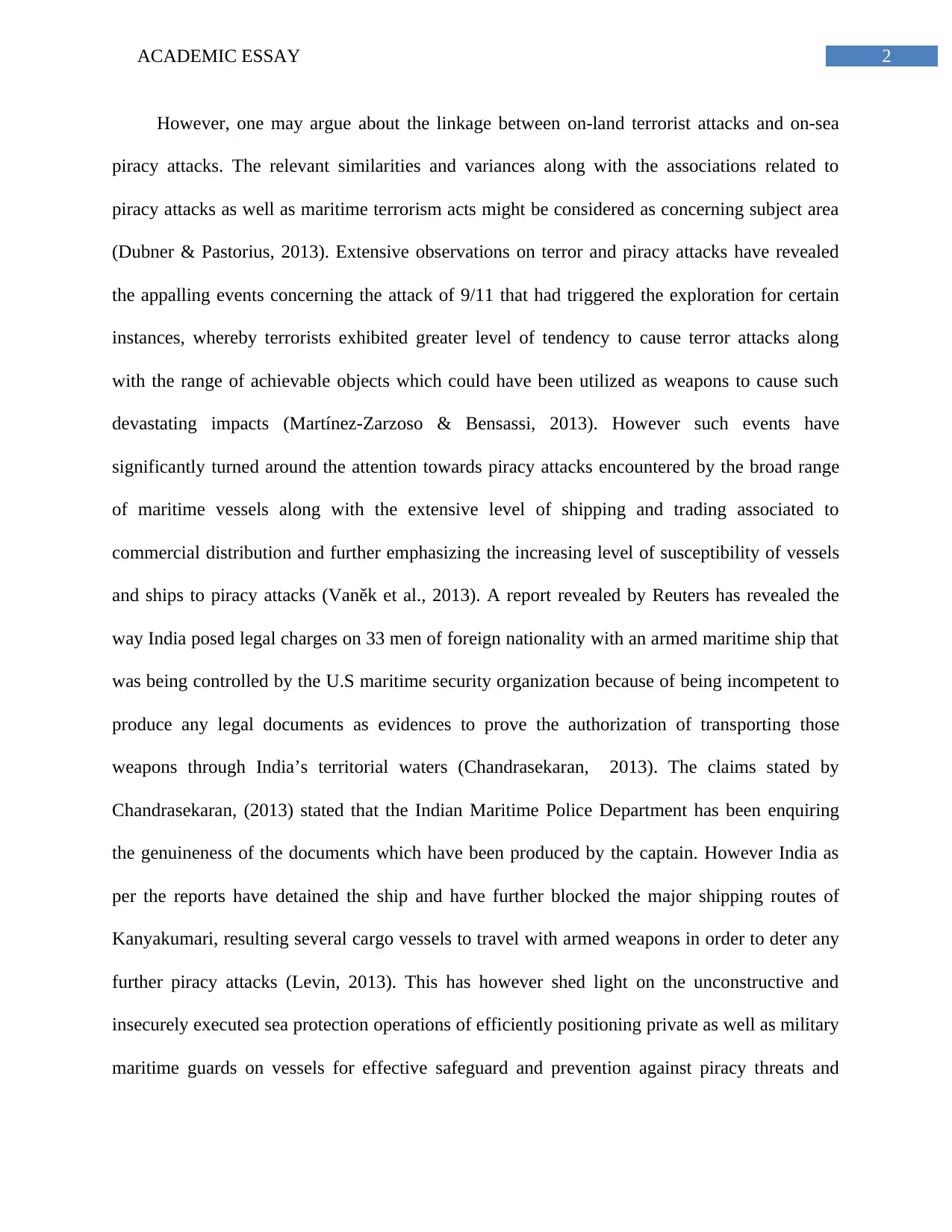
2ACADEMIC ESSAY
However, one may argue about the linkage between on-land terrorist attacks and on-sea
piracy attacks. The relevant similarities and variances along with the associations related to
piracy attacks as well as maritime terrorism acts might be considered as concerning subject area
(Dubner & Pastorius, 2013). Extensive observations on terror and piracy attacks have revealed
the appalling events concerning the attack of 9/11 that had triggered the exploration for certain
instances, whereby terrorists exhibited greater level of tendency to cause terror attacks along
with the range of achievable objects which could have been utilized as weapons to cause such
devastating impacts (Martínez-Zarzoso & Bensassi, 2013). However such events have
significantly turned around the attention towards piracy attacks encountered by the broad range
of maritime vessels along with the extensive level of shipping and trading associated to
commercial distribution and further emphasizing the increasing level of susceptibility of vessels
and ships to piracy attacks (Vaněk et al., 2013). A report revealed by Reuters has revealed the
way India posed legal charges on 33 men of foreign nationality with an armed maritime ship that
was being controlled by the U.S maritime security organization because of being incompetent to
produce any legal documents as evidences to prove the authorization of transporting those
weapons through India’s territorial waters (Chandrasekaran, 2013). The claims stated by
Chandrasekaran, (2013) stated that the Indian Maritime Police Department has been enquiring
the genuineness of the documents which have been produced by the captain. However India as
per the reports have detained the ship and have further blocked the major shipping routes of
Kanyakumari, resulting several cargo vessels to travel with armed weapons in order to deter any
further piracy attacks (Levin, 2013). This has however shed light on the unconstructive and
insecurely executed sea protection operations of efficiently positioning private as well as military
maritime guards on vessels for effective safeguard and prevention against piracy threats and
However, one may argue about the linkage between on-land terrorist attacks and on-sea
piracy attacks. The relevant similarities and variances along with the associations related to
piracy attacks as well as maritime terrorism acts might be considered as concerning subject area
(Dubner & Pastorius, 2013). Extensive observations on terror and piracy attacks have revealed
the appalling events concerning the attack of 9/11 that had triggered the exploration for certain
instances, whereby terrorists exhibited greater level of tendency to cause terror attacks along
with the range of achievable objects which could have been utilized as weapons to cause such
devastating impacts (Martínez-Zarzoso & Bensassi, 2013). However such events have
significantly turned around the attention towards piracy attacks encountered by the broad range
of maritime vessels along with the extensive level of shipping and trading associated to
commercial distribution and further emphasizing the increasing level of susceptibility of vessels
and ships to piracy attacks (Vaněk et al., 2013). A report revealed by Reuters has revealed the
way India posed legal charges on 33 men of foreign nationality with an armed maritime ship that
was being controlled by the U.S maritime security organization because of being incompetent to
produce any legal documents as evidences to prove the authorization of transporting those
weapons through India’s territorial waters (Chandrasekaran, 2013). The claims stated by
Chandrasekaran, (2013) stated that the Indian Maritime Police Department has been enquiring
the genuineness of the documents which have been produced by the captain. However India as
per the reports have detained the ship and have further blocked the major shipping routes of
Kanyakumari, resulting several cargo vessels to travel with armed weapons in order to deter any
further piracy attacks (Levin, 2013). This has however shed light on the unconstructive and
insecurely executed sea protection operations of efficiently positioning private as well as military
maritime guards on vessels for effective safeguard and prevention against piracy threats and
⊘ This is a preview!⊘
Do you want full access?
Subscribe today to unlock all pages.

Trusted by 1+ million students worldwide
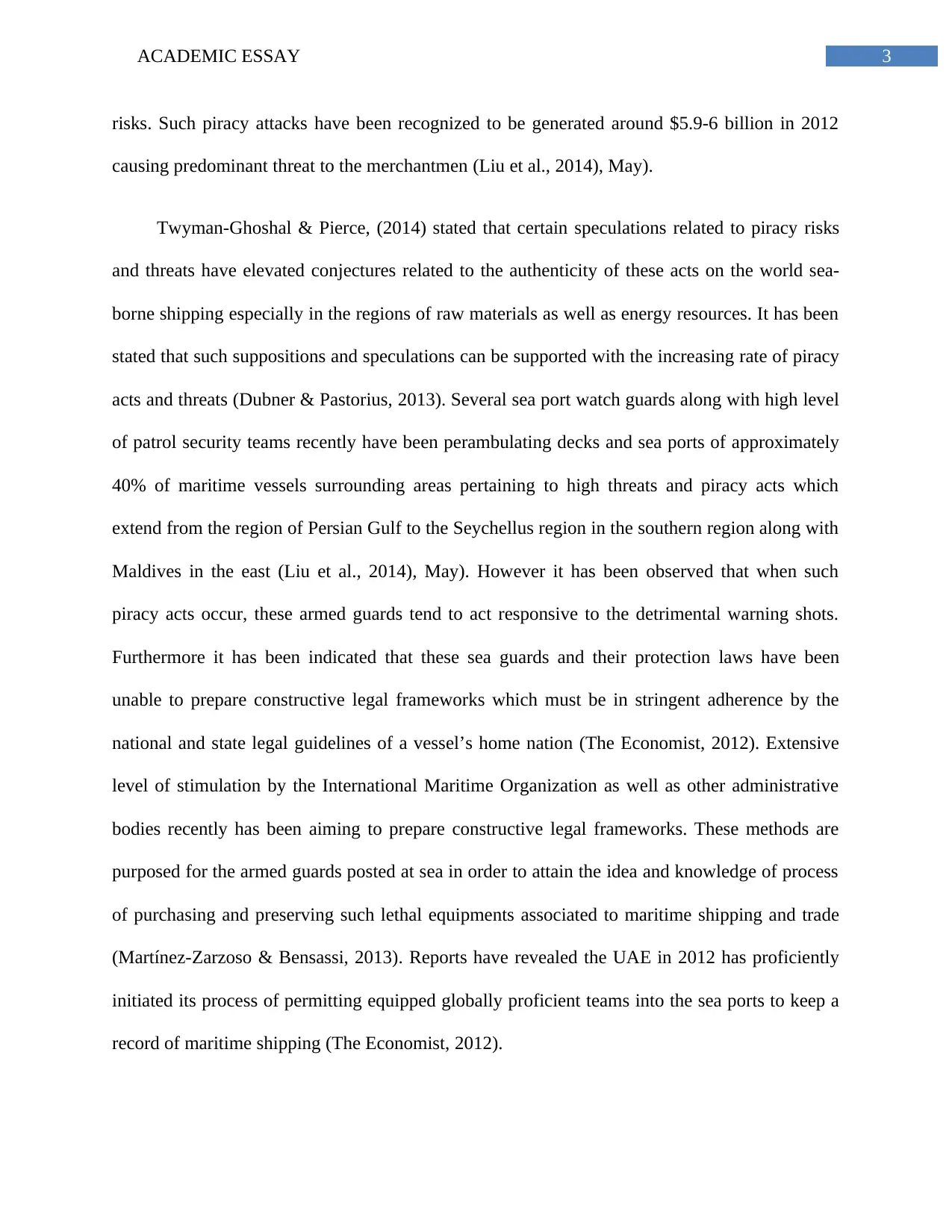
3ACADEMIC ESSAY
risks. Such piracy attacks have been recognized to be generated around $5.9-6 billion in 2012
causing predominant threat to the merchantmen (Liu et al., 2014), May).
Twyman-Ghoshal & Pierce, (2014) stated that certain speculations related to piracy risks
and threats have elevated conjectures related to the authenticity of these acts on the world sea-
borne shipping especially in the regions of raw materials as well as energy resources. It has been
stated that such suppositions and speculations can be supported with the increasing rate of piracy
acts and threats (Dubner & Pastorius, 2013). Several sea port watch guards along with high level
of patrol security teams recently have been perambulating decks and sea ports of approximately
40% of maritime vessels surrounding areas pertaining to high threats and piracy acts which
extend from the region of Persian Gulf to the Seychellus region in the southern region along with
Maldives in the east (Liu et al., 2014), May). However it has been observed that when such
piracy acts occur, these armed guards tend to act responsive to the detrimental warning shots.
Furthermore it has been indicated that these sea guards and their protection laws have been
unable to prepare constructive legal frameworks which must be in stringent adherence by the
national and state legal guidelines of a vessel’s home nation (The Economist, 2012). Extensive
level of stimulation by the International Maritime Organization as well as other administrative
bodies recently has been aiming to prepare constructive legal frameworks. These methods are
purposed for the armed guards posted at sea in order to attain the idea and knowledge of process
of purchasing and preserving such lethal equipments associated to maritime shipping and trade
(Martínez-Zarzoso & Bensassi, 2013). Reports have revealed the UAE in 2012 has proficiently
initiated its process of permitting equipped globally proficient teams into the sea ports to keep a
record of maritime shipping (The Economist, 2012).
risks. Such piracy attacks have been recognized to be generated around $5.9-6 billion in 2012
causing predominant threat to the merchantmen (Liu et al., 2014), May).
Twyman-Ghoshal & Pierce, (2014) stated that certain speculations related to piracy risks
and threats have elevated conjectures related to the authenticity of these acts on the world sea-
borne shipping especially in the regions of raw materials as well as energy resources. It has been
stated that such suppositions and speculations can be supported with the increasing rate of piracy
acts and threats (Dubner & Pastorius, 2013). Several sea port watch guards along with high level
of patrol security teams recently have been perambulating decks and sea ports of approximately
40% of maritime vessels surrounding areas pertaining to high threats and piracy acts which
extend from the region of Persian Gulf to the Seychellus region in the southern region along with
Maldives in the east (Liu et al., 2014), May). However it has been observed that when such
piracy acts occur, these armed guards tend to act responsive to the detrimental warning shots.
Furthermore it has been indicated that these sea guards and their protection laws have been
unable to prepare constructive legal frameworks which must be in stringent adherence by the
national and state legal guidelines of a vessel’s home nation (The Economist, 2012). Extensive
level of stimulation by the International Maritime Organization as well as other administrative
bodies recently has been aiming to prepare constructive legal frameworks. These methods are
purposed for the armed guards posted at sea in order to attain the idea and knowledge of process
of purchasing and preserving such lethal equipments associated to maritime shipping and trade
(Martínez-Zarzoso & Bensassi, 2013). Reports have revealed the UAE in 2012 has proficiently
initiated its process of permitting equipped globally proficient teams into the sea ports to keep a
record of maritime shipping (The Economist, 2012).
Paraphrase This Document
Need a fresh take? Get an instant paraphrase of this document with our AI Paraphraser
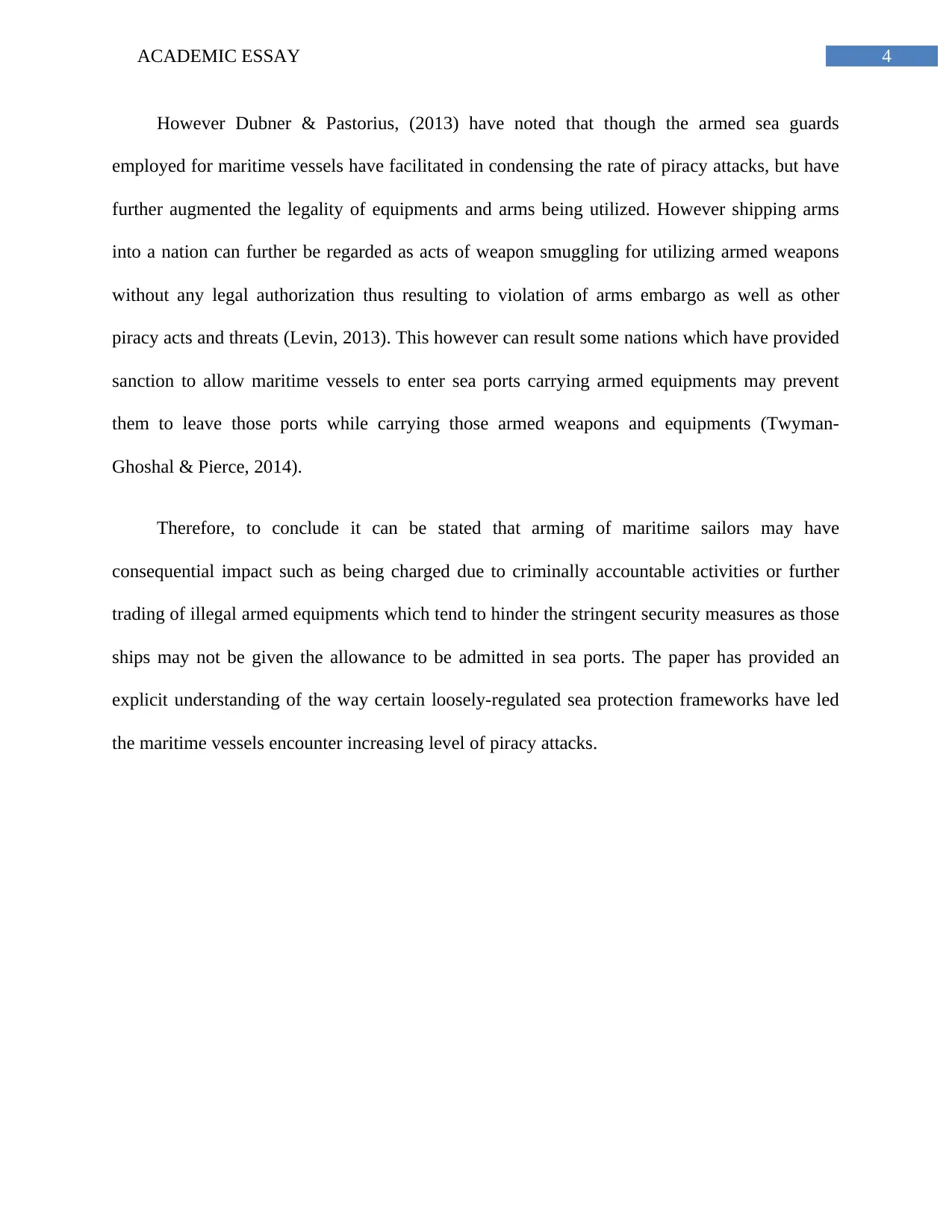
4ACADEMIC ESSAY
However Dubner & Pastorius, (2013) have noted that though the armed sea guards
employed for maritime vessels have facilitated in condensing the rate of piracy attacks, but have
further augmented the legality of equipments and arms being utilized. However shipping arms
into a nation can further be regarded as acts of weapon smuggling for utilizing armed weapons
without any legal authorization thus resulting to violation of arms embargo as well as other
piracy acts and threats (Levin, 2013). This however can result some nations which have provided
sanction to allow maritime vessels to enter sea ports carrying armed equipments may prevent
them to leave those ports while carrying those armed weapons and equipments (Twyman-
Ghoshal & Pierce, 2014).
Therefore, to conclude it can be stated that arming of maritime sailors may have
consequential impact such as being charged due to criminally accountable activities or further
trading of illegal armed equipments which tend to hinder the stringent security measures as those
ships may not be given the allowance to be admitted in sea ports. The paper has provided an
explicit understanding of the way certain loosely-regulated sea protection frameworks have led
the maritime vessels encounter increasing level of piracy attacks.
However Dubner & Pastorius, (2013) have noted that though the armed sea guards
employed for maritime vessels have facilitated in condensing the rate of piracy attacks, but have
further augmented the legality of equipments and arms being utilized. However shipping arms
into a nation can further be regarded as acts of weapon smuggling for utilizing armed weapons
without any legal authorization thus resulting to violation of arms embargo as well as other
piracy acts and threats (Levin, 2013). This however can result some nations which have provided
sanction to allow maritime vessels to enter sea ports carrying armed equipments may prevent
them to leave those ports while carrying those armed weapons and equipments (Twyman-
Ghoshal & Pierce, 2014).
Therefore, to conclude it can be stated that arming of maritime sailors may have
consequential impact such as being charged due to criminally accountable activities or further
trading of illegal armed equipments which tend to hinder the stringent security measures as those
ships may not be given the allowance to be admitted in sea ports. The paper has provided an
explicit understanding of the way certain loosely-regulated sea protection frameworks have led
the maritime vessels encounter increasing level of piracy attacks.
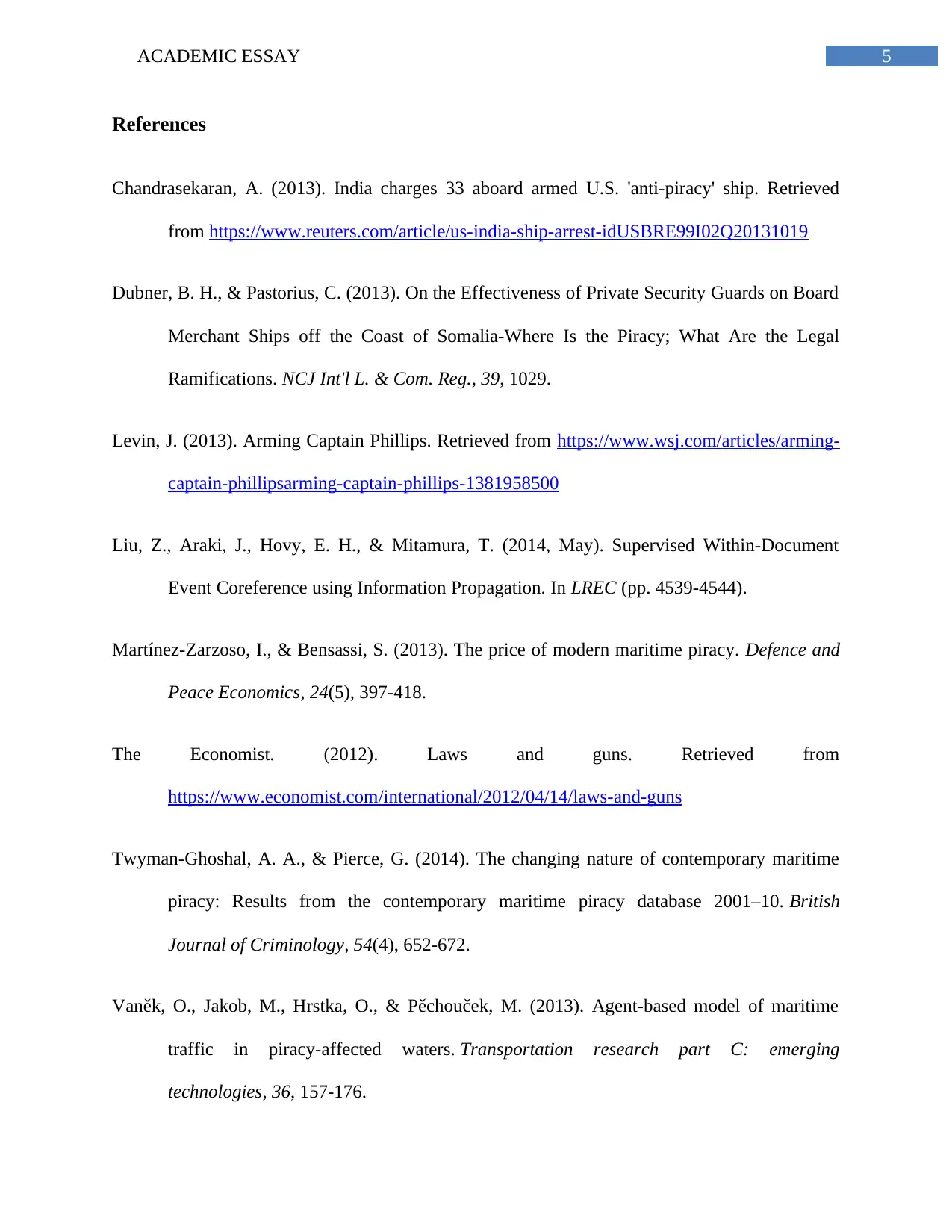
5ACADEMIC ESSAY
References
Chandrasekaran, A. (2013). India charges 33 aboard armed U.S. 'anti-piracy' ship. Retrieved
from https://www.reuters.com/article/us-india-ship-arrest-idUSBRE99I02Q20131019
Dubner, B. H., & Pastorius, C. (2013). On the Effectiveness of Private Security Guards on Board
Merchant Ships off the Coast of Somalia-Where Is the Piracy; What Are the Legal
Ramifications. NCJ Int'l L. & Com. Reg., 39, 1029.
Levin, J. (2013). Arming Captain Phillips. Retrieved from https://www.wsj.com/articles/arming-
captain-phillipsarming-captain-phillips-1381958500
Liu, Z., Araki, J., Hovy, E. H., & Mitamura, T. (2014, May). Supervised Within-Document
Event Coreference using Information Propagation. In LREC (pp. 4539-4544).
Martínez-Zarzoso, I., & Bensassi, S. (2013). The price of modern maritime piracy. Defence and
Peace Economics, 24(5), 397-418.
The Economist. (2012). Laws and guns. Retrieved from
https://www.economist.com/international/2012/04/14/laws-and-guns
Twyman-Ghoshal, A. A., & Pierce, G. (2014). The changing nature of contemporary maritime
piracy: Results from the contemporary maritime piracy database 2001–10. British
Journal of Criminology, 54(4), 652-672.
Vaněk, O., Jakob, M., Hrstka, O., & Pěchouček, M. (2013). Agent-based model of maritime
traffic in piracy-affected waters. Transportation research part C: emerging
technologies, 36, 157-176.
References
Chandrasekaran, A. (2013). India charges 33 aboard armed U.S. 'anti-piracy' ship. Retrieved
from https://www.reuters.com/article/us-india-ship-arrest-idUSBRE99I02Q20131019
Dubner, B. H., & Pastorius, C. (2013). On the Effectiveness of Private Security Guards on Board
Merchant Ships off the Coast of Somalia-Where Is the Piracy; What Are the Legal
Ramifications. NCJ Int'l L. & Com. Reg., 39, 1029.
Levin, J. (2013). Arming Captain Phillips. Retrieved from https://www.wsj.com/articles/arming-
captain-phillipsarming-captain-phillips-1381958500
Liu, Z., Araki, J., Hovy, E. H., & Mitamura, T. (2014, May). Supervised Within-Document
Event Coreference using Information Propagation. In LREC (pp. 4539-4544).
Martínez-Zarzoso, I., & Bensassi, S. (2013). The price of modern maritime piracy. Defence and
Peace Economics, 24(5), 397-418.
The Economist. (2012). Laws and guns. Retrieved from
https://www.economist.com/international/2012/04/14/laws-and-guns
Twyman-Ghoshal, A. A., & Pierce, G. (2014). The changing nature of contemporary maritime
piracy: Results from the contemporary maritime piracy database 2001–10. British
Journal of Criminology, 54(4), 652-672.
Vaněk, O., Jakob, M., Hrstka, O., & Pěchouček, M. (2013). Agent-based model of maritime
traffic in piracy-affected waters. Transportation research part C: emerging
technologies, 36, 157-176.
⊘ This is a preview!⊘
Do you want full access?
Subscribe today to unlock all pages.

Trusted by 1+ million students worldwide
1 out of 6
Your All-in-One AI-Powered Toolkit for Academic Success.
+13062052269
info@desklib.com
Available 24*7 on WhatsApp / Email
![[object Object]](/_next/static/media/star-bottom.7253800d.svg)
Unlock your academic potential
Copyright © 2020–2025 A2Z Services. All Rights Reserved. Developed and managed by ZUCOL.
